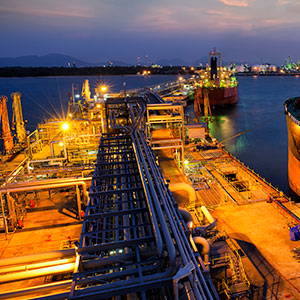The Next Phase of the Asia-Pacific's Energy Revolution
On December 14, 2016, NBR hosted “The Next Phase of the Asia-Pacific’s Energy Revolution,” a public discussion that examined how a range of factors—including market volatility, efforts to accelerate lower-carbon transitions, regional geopolitics, and Paris Climate Accord commitments—shape energy security outlooks in the Asia-Pacific. The event marked the launch of NBR’s twelfth annual Energy Security Report, “Asia’s Energy Security amid Global Market Change,” and recapped findings from NBR’s seventh annual Pacific Energy Summit, held in Singapore in June.
Speakers
Moderator
Clara Gillispie, The National Bureau of Asian Research
Panelists
Mikkal E. Herberg, The National Bureau of Asian Research
Younkyoo Kim, Hanyang University
Meghan L. O’Sullivan, Harvard University
Fei YU, Asian Development Bank
Event Summary
Following opening remarks by Roy D. Kamphausen, senior vice president for research at NBR and director of NBR’s Washington, D.C., office, Clara Gillispie, senior director of trade, economic, and energy affairs at NBR, introduced the panelists and set the tone for the discussion to follow. In her remarks, Ms. Gillispie framed the conversation through the lens of the unique characteristics of the Asia-Pacific, which despite now contributing nearly 50% of world GDP still has 700 million people who lack access to electricity. She also highlighted the immense challenges that governments face in the region for how to best meet rising demand for energy to sustain economic growth while protecting the environment.
The ensuing panel discussion began with remarks by Mikkal E. Herberg (NBR). He described the underlying themes of the meeting in greater detail, touching on massive changes in technology as exhibited by the shale gas revolution; long-run risks in oil, LNG, and geopolitics; improved energy security from abundant supplies; and the benefits of lower prices for Asia’s economic development. He also emphasized that in this period of low prices and abundance, governments should not reduce investment in oil and gas infrastructure, since a return of higher prices in the future could result in supply shortages. Additionally, Mr. Herberg noted that close attention must be paid to open navigation of sea lanes in the region, which will be crucial for maintaining energy security in the future.
Meghan L. O’Sullivan (Harvard University) echoed Mr. Herberg’s concerns about energy security in the region and provided three topics of discussion. First, she highlighted Russia’s “pivot to Asia” as a potential game changer in geopolitical relations and energy trade in the Asia-Pacific. However, Dr. O’Sullivan noted that low prices and current sanctions against Russia have impeded this pivot from coming to fruition. Second, she discussed the role of the Middle East in Asia’s energy markets. With lower prices, Asia is more dependent on oil and gas from the Middle East; at the same time, lower prices make the Middle East more unstable, resulting in threats to supply continuity. Finally, Dr. O’Sullivan commented on the nature of Chinese foreign policy and its evolution over the past several years. In the pursuit of additional energy resource suppliers, China is increasingly looking west to Central Asia, thereby changing some of the regional geopolitical dynamics.
Younkyoo Kim (Hanyang University) emphasized that it is still unclear which fuel will fill the gap in Asia to meet both rising energy demand and Paris climate commitments. Dr. Kim highlighted that the unconventional oil and gas revolution in the United States and prospects of exports to Asia were viewed as a great opportunity by the Republic of Korea. As a result, the government set a goal to cut 20% of dependence on oil and gas from the Middle East by importing those supplies from the United States instead. An additional strategy was focused on increasing trade with Russia as an opportunity to further diversify suppliers and supply routes. Dr. Kim noted that various factors over the past two years (including steep price declines that have complicated the economics of particular projects, ongoing pipeline politics challenges, and sanctions on Russia) have disrupted both plans. However, Dr. Kim was optimistic that in the coming years, supply and demand will rebalance and the Republic of Korea will be able to revisit LNG trade with the United States.
Fei Yu (Asian Development Bank) provided a detailed analysis of the complexities of China’s changing energy dynamics. In 2015, the service sector in China comprised 50% of overall GDP and 60% of GDP growth. This is a major shift in a country that has long depended on the heavy energy sector to drive growth. Market change has been accompanied with slowing energy consumption—from 2002 to 2012, energy consumption grew by 8.0% each year but decreased to 0.9% growth in 2015. These positive trends are in line with China’s goals to improve environmental sustainability, yet there are still many issues troubling policymakers. One area of particular concern is air pollution. Half of China’s population is affected by smog, and it is estimated that high concentrations of PM2.5 result in one million premature deaths each year. Dr. Yu emphasized both the health and national security benefits of China reaching its peak coal target and expanding its efforts to increase renewables in the country’s energy mix.
The public discussion dug deeper into many of the issues raised by the panelists but also introduced other topics pertaining to the overarching theme. The panelists agreed on the importance of a country balancing its energy mix to include not only a variety of fuels but also a range of sources. However, they also acknowledged the challenge of meeting these goals due to cost differentials between fuels and the lack of large domestic reserves for many countries in the region. Finally, the panel emphasized the importance of enhanced collaboration to help countries throughout the Asia-Pacific meet both environmental and economic goals.
Photo Gallery




